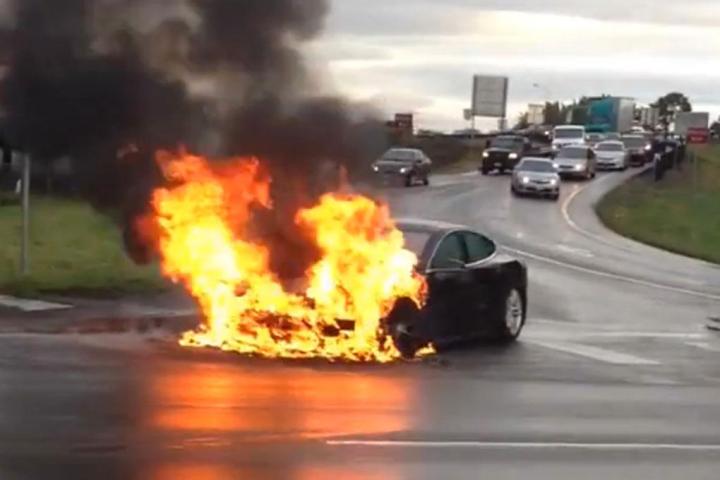
Tesla may have a problem on its hands. The third Model S in six weeks just went up in flames.
The fire happened Wednesday outside of Smyrna, Tennessee. Awkwardly for Tesla, that happens to be where Nissan’s Leaf EV is manufactured. One can only imagine the Nissan engineers gathering around the burned out hulk of the Model S for a good round of Schadenfreude.
The previous fires in Kent Washington, and Mexico also involved serious collisions.
Fortunately it, as with the previous accidents, no one was injured, and according to Tesla’s statement to the Detroit News the driver believes “the car saved his life.”
The owner of the crashed Tesla S, Juris Shibayama, has written an account of the crash that is now being distributed by the automaker. Shibayama reports that he was traveling at about 70 mph on the highway when he struck a trailer hitch that was lying ball up in the road. He reported that the impact felt like it almost lifted the car. After receiving several warnings from the car’s onboard systems he pulled over and got out. Approximately 20 seconds after he exited the car smoke began to come out from under the hood. He had time to remove himself from the scene before the car actually caught fire. The fire never entered the passenger cabin, and Shibayama was able to remotely unlock the car for firefighters even after the battery pack caught fire. He reiterated Tesla’s earlier statement that he felt the car saved his life.
Similar statements were released after each of the two previous fires, so Tesla either has a very loyal customer base, or Tesla CEO Elon Musk is breaking out his lithium-ion checkbook.
The particularly impressive detail of this story to me, is the ability of the car’s onboard systems to warn the driver in advance of the fire breaking out. It may as good as no fire, but it speaks highly of the Tesla’s overall safety.
It is worth noting that there are more than 180,000 car fires annually in the United States, and so three crispy Teslas are a drop in the bucket. However, this is a disturbing trend, if only because people keep crashing their Teslas – slow down guys; electricity does not magically improve traction.
Also worth noting, there have been no reported fires involving the Nissan Leaf or the Chevy Volt. These two EVs have sold more units than the Model S – Nissan has sold 70,000 Leafs to Tesla’s 19,000 Model S’s – so there may be more than a statistical anomaly at work.

If that’s the case Mr. Musk may need to put smugness aside and ask GM and Nissan for some pointers. We all know that he invented electricity and space travel, but that has not kept some experts from speculating that the Tesla’s battery placement is part of the problem.
Because it is located so low in the vehicle, some engineers have speculated debris may be striking it during impacts and triggering these fires. A conclusion strongly reinforced by the details of this crash. Given the somewhat antiseptic nature of crash testing, it is possible that a problem created by scattered debris might not have been detected.
So far, though the National Highway Traffic Safety Administration has declined to begin an investigation, but they are in contact with Tennessee police to see if there is cause for concern. Tesla remains adamant that these fires are an anomaly and that there cars are well engineered.
All joking aside we hope that Tesla is right when it says that there is no cause for concern. It would be a terrible loss for the motoring world to see the exciting and polarizing Tesla lost to safety issue. Check back as we update this story with more details regarding the crash.
Update: This story has been updated with details of the crash. These details come from an account by the driver, distributed by Tesla.


